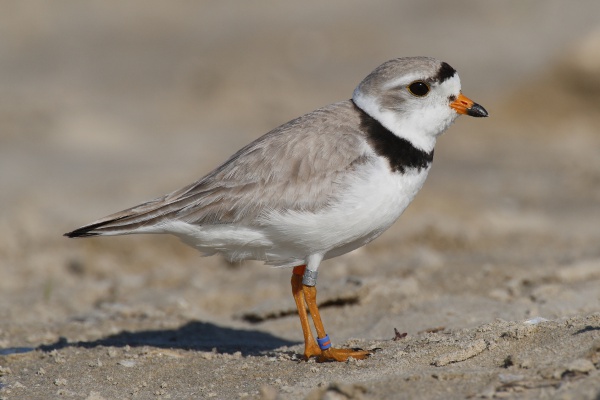Facts About Piping plover
The piping plover is a small shorebird commonly found on the sandy and gravelly beaches of North America. Resembling a sparrow in size, this bird is easily identifiable by its yellow-orange legs, a black band across its forehead, and another black stripe across its breast. During the breeding season, distinguishing between males and females is possible by the chest band, which is typically thicker in males.
Spotting a piping plover can be challenging because they blend seamlessly with their beachy surroundings. They often dart in short bursts and then stop suddenly, making them even harder to see.
There are two main groups of piping plovers: the eastern population, known as *Charadrius melodus melodus*, and the mid-western population, called *C. m. circumcinctus*. The bird gets its name from its bell-like whistles, which you might hear before you actually see it. Currently, there are about 6,510 piping plovers, and their numbers have been increasing since 1999.
Piping plovers inhabit beaches and sand flats along the Atlantic coast, the Great Lakes, and the mid-west regions of Canada and the U.S. They nest on sandy or gravelly beaches and feed on insects, marine worms, and small crustaceans found along the water’s edge.
These birds have a stout body, rounded head, short neck, and a stubby bill. Their sand-colored feathers help them blend in with their surroundings. They communicate with soft whistles and alarm calls and migrate between their northern breeding grounds and southern wintering areas, including the Caribbean.
During the breeding season, piping plovers engage in elaborate courtship rituals, build nests, and incubate their eggs. Conservation efforts are in place to protect their nesting habitats from predators and human disturbances. The piping plover is listed as endangered or threatened in various regions, with efforts focused on preserving nesting sites, limiting human activities near nests, and controlling predators.
Many organizations are working diligently to protect the piping plover population. These efforts include closing off certain beach areas, educating the public, and restricting vehicle and foot traffic near nesting sites. Despite these measures, the piping plover remains at risk, and continuous conservation work is crucial for their survival.

 Canada
Canada